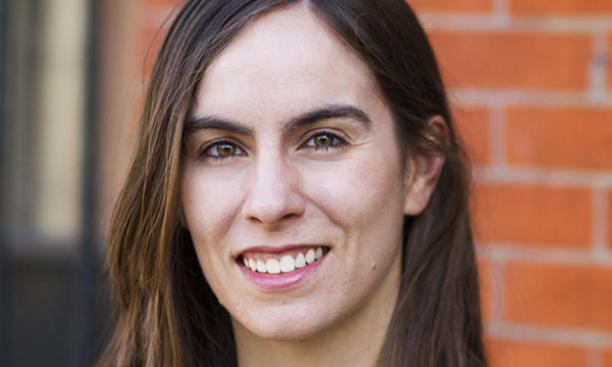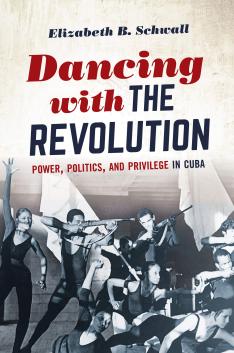
The book: In Dancing with the Revolution: Power, Politics, and Privilege in Cuba (The University of North Carolina Press), Elizabeth Schwall ’09 examines the intersection of art and politics during the Cuban Revolution. Through a deep historical analysis of the world of Cuban dance, Schwall explores how ballet, modern, and folkloric dancers negotiated with the Cuban governments before and after the 1959 Cuban Revolution. With a curiosity in the power that dance holds in society, Schwall began pouring through the archives of written and visual documents of Cuban dance and the conversation surrounding art at the time. Schwall concluded that these dancers used their physical bodies to critique political leaders and propose a more progressive norm. Often overlooked in traditional narratives, Schwall demonstrates how the multifaceted histories of Latin America and the Caribbean can provide a new perspective on the development of ideology through the lens of art.
The author: Elizabeth Schwall ’09 is an assistant professor of history at Northern Arizona University. Her work mainly focuses on how physical movements inform politics and society in the 20th century. Schwall approaches her teaching and writing through an interdisciplinary lens, using gender, race, culture, and migration to examine the different ways dance has held power in society.Excerpt: In photographs from the early 1970s, Cuban modern dancers appear ready for battle. In one image, four men clutch rifles, a woman raises a flag, several stare down an imagined enemy, and two women defiantly thrust their hands into the air (see figure I.1). Luz María Collazo, the woman on the far left with her open hand raised and leg extended in a firm but buoyant stance, did not remember the photo
shoot. Isidro Rolando, her longtime colleague and friend who appears in other images in the series, recalled it fondly. As a gentle breeze and loud street noises spilled through an open window in Rolando’s living room, he reminded Collazo and explained to me that the photographs had inspired posters that appeared on each block of the main drive, Paseo, which leads toward the Plaza of the Revolution in Havana. Dancers improvised to embody official annual themes from the previous decade and a half: the Year of Agrarian Reform, Year of the Literacy Campaign, and others. Although the abstracted figures on the final posters did not look like dancers, they had “poetry” and “certain movement,” which indicated their source.
Their moving militancy glossed a more complicated backstory. A few years earlier, the government had censored the modern dancers, causing a company crisis and a “very painful moment of much confusion,” according to Collazo. However, modern dancers persisted, staging new works and advocating behind the scenes. Shortly thereafter, they appeared on posters to model revolutionary accomplishments. Their aggressive stances, then, above all reflected their resolve, honed after years of cultivating and navigating their relationship with the state. They fought to secure a place along Paseo, and by extension, in Cuban cultural and political life. Because of their work, dance became an important cultural expression of the Revolution, and dancers, compelling avatars of full bodied investment in political projects.
The history of dancers like Rolando and Collazo provides important insight into Cuban politics writ large. In 1959, Fidel Castro and his 26th of July Movement led a broad coalition to declare a revolutionary “triumph” against the ousted leader, Fulgencio Batista. Dancers, like other Cuban citizens, built on precedents to forge tactical relationships with the new regime, and revolutionary ideals motivated their subsequent actions. For dancers, political prompts led to particularly vivid outcomes: they defensively lunged and raised their fists in the photograph, for instance. Their bodies in motion evidence how politics in Cuba were not just spoken but also performed. Dancers in fact had particular capacity to express adhesion to the revolutionary project, as well as critiques thanks to the nonverbal nature of their art. Moreover, dancers like Collazo publicly conveyed revolutionary support as illustrated in the photoshoot despite recent backstage drama and any disaffection it may have caused. Ultimately, even as the Revolution inspired dancers, final aesthetic outcomes remained the product of their individual imaginations and physicalities. Thus, dance foregrounds the requisite performances of public support, the shrouded tensions, and the spaces for agency involved in literally and metaphorically dancing with the Revolution as an idea and a concrete ruling structure. Just as dancers became emblems of Cuban citizens in the posters, I see their stories as emblematic of broader political histories on the island. Consequently, examining how dancers partnered with the state reveals the ideological forces, physical movements, bold performances, and poised resilience inherent to navigating politics in revolutionary Cuba for dancing and nondancing citizens alike.
To explore these political histories, I examine concert dance developments from 1930 to 1990. This means focusing on staged choreography rather than revelry or ritual dances that often occurred outside of nationalized institutions. During the crucial period of the 1930s through the 1950s, Cuban dancers and audiences established the social and cultural importance of concert dance. After 1959, dance makers an expansive term that refers to performers, teachers, choreographers, company directors, and students built on precedents to create revolutionary dance institutions and productions. Mixing the old with the new, dance makers instructed, entertained, employed, and politically provoked Cubans in a revolutionary context. As a result oftheir efforts, by the 1980s Cuba had become an internationally renowned dance center.
Scholars have often attributed concert dance achievements in Cuba to official cultural policies, but dance makers were not passive beneficiaries (or victims, depending on the political perspective). They in fact spearheaded hallmark dance developments. The active stances that Rolando, Collazo, and their colleagues took to embody revolutionary politics for the photoshoot encapsulated their energetic role in securing resources to build audiences and establish their art as intrinsic to revolutionary culture. Their efforts paid off. Castro saw companies off at the airport, attended their performances with visiting dignitaries in tow, and referenced their distinctions in major speeches.However, their status was never a foregone conclusion. Dance makers had to contend with authoritarianism and fight to assert power as they brought a cultural industry into being in collaboration with officials who ranged from obliging to hostile to apathetic to everything in between.
Review: This formidable history and critical appraisal of dance in Cuba compellingly argues that dance is, among other things, a practice of social and political expression, one in which dancers have explored the reach and limits of state power. A rich and powerful study of how dance institutions and practitioners revealed and enacted the contradictions of the Revolution itself, particularly in relation to racial inequality." —Jill Lane, New York University

